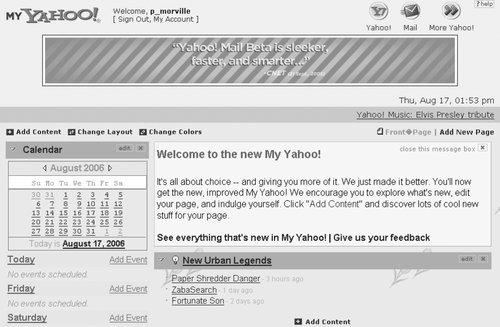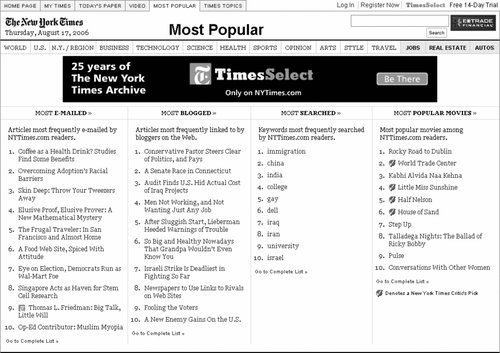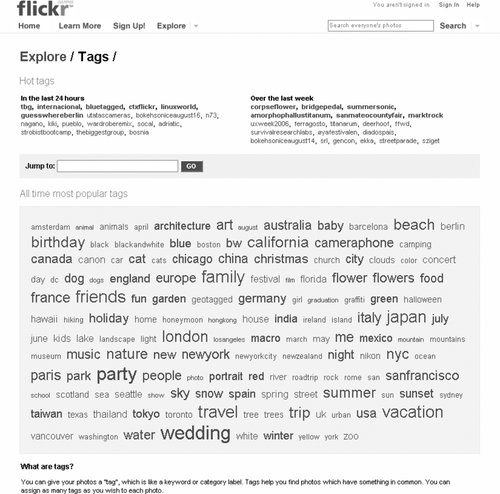Section 7.8. Advanced Navigation Approaches
7.8. Advanced Navigation ApproachesSo far, we've focused attention on the bread-and-butter components of navigation systems, the elements that form the foundation of useful, usable web sites. Good navigation design is really important and really hard. Only after you've mastered the integration of these fundamental building blocks should you dare wander into the minefield of advanced navigation. 7.8.1. Personalization and CustomizationPersonalization involves serving up tailored pages to the user based upon a model of the behavior, needs, or preferences of that individual. In contrast, customization involves giving the user direct control over some combination of presentation, navigation, and content options. In short, with personalization, we guess what the user wants, and with customization, the user tells us what he wants. Both personalization and customization can be used to refine or supplement existing navigation systems. Unfortunately, however, both have been hyped by consultants and software vendors as the solution to all navigation problems. The reality is that personalization and customization:
Personalization has preoccupied marketing folks in recent years, partly due to the influential book by Don Peppers and Martha Rogers, The One to One Future (Doubleday). On a web site, you might use demographic data (e.g., age, sex, income level, zip code) and previous purchasing behavior to make educated guesses about which products to feature in the contextual navigation system during a customer's next visit. On an intranet, you might use role and job function as a basis for filtering views of news and e-service applications; for example, personalization is essential for controlling access to human-resource applications involving compensation and benefits. Amazon is the most cited example of successful personalization, and some of the things it's done are truly valuable. It's nice that Amazon remembers our names, and it's great that it remembers our address and credit card information. It's when Amazon starts trying to recommend books based on past purchases that the system breaks down (see Figure 7-23). In this example, Peter already owns two of the top three recommended books, but the system doesn't know this because he didn't purchase them from Amazon. And this ignorance is not the exception but the rule. Because we don't have time to teach our systems, or because we prefer to maintain our privacy, we often don't share enough information to drive effective personalization. In addition, in many cases, it's really hard to guess what people will want to do or learn or buy tomorrow. As they say in the financial world, past performance is no guarantee of future results. In short, personalization works really well in limited contexts, but fails when you try to expand it to drive the entire user experience. Figure 7-23. Amazon's personalized recommendations Customization introduces a similar set of promises and perils. The idea of giving users control and thereby alleviating some of the pressures on design is obviously very compelling. And customization can sometimes deliver great value. My Yahoo! (Figure 7-24) and more recently, MySpace, are flagship examples and provide all sorts of customization capabilities, which many users take full advantage offor better or for worse. Figure 7-24. Customization at My Yahoo! The problem with customization is that most people don't want to spend much (if any) time customizing, and will do this work only on a small handful of sites that are most important to them. Since corporate intranets have a captive audience of repeat visitors, customization has a much better chance of being used there than it does on most public web sites. However, there's another problem. Even users themselves don't always know what they will want to know or do tomorrow. Customization works great for tracking the sports scores of your favorite baseball team or monitoring the value of stocks you own, but not so well when it comes to broader news and research needs. One day you want to know the results of the French elections; the next day you want to know when dogs were first domesticated. Do you really know what you might need next month? 7.8.2. VisualizationSince the advent of the Web, people have struggled to create useful tools that enable users to navigate in a more visual way. First came the metaphor-driven attempts to display online museums, libraries, shopping malls, and other web sites as physical places. Then came the dynamic, fly-through "sitemaps" that tried to show relationships between pages on a web site. Both looked very cool and stretched our imaginations. But neither proved to be very useful. Even today, high-profile companies such as Groxis continue to explore the potential of visualization for navigation. Grokker, its enterprise search product, allows you to create visual navigation experiences for users (see Figure 7-25). It's worth keeping an eye on these experiments, but we remain skeptical that these approaches will prove useful for mainstream search and navigation. Figure 7-25. Grokker's visual search results 7.8.3. Social NavigationOn a more positive note, social navigation, built on the premise that value for the individual user can be derived from observing the actions of other users, continues to hold great promise and is already on the fast track to mainstream adoption. Simple examples include lists of most popular resources, such as the New York Times' Most Popular (see Figure 7-26). Figure 7-26. Most Popular at the New York Times More sophisticated examples include Amazon's collaborative filtering (see Figure 7-27), Epinions' recommendation engine (see http://www.epinions.com), and Flickr's beloved tag clouds, shown in Figure 7-28, which use font size to show tag popularity. Perhaps there is a future for visualization after all. Figure 7-27. Amazon's collaborative filtering While most companies aren't yet employing social navigation approaches on their web sites and intranets, we expect the practice to become increasingly common in the coming years. At a minimum, companies will find ways to unlock the value currently trapped in their search logs, usage statistics, and customer databases to drive more effective contextual navigation. We also hope to see more ambitious solutions that tap this feedback loop between design and behavior, creating adaptive navigation systems that significantly advance the usability of our web sites and intranets. Figure 7-28. Flickr's tag clouds In the past several years, the design of navigation systems has improved in a rapid and highly visible manner. If you need convincing, just check out a few sites from the mid-90s using the Internet Archive's Wayback Machine (http://www.archive.org/). Let's hope we can keep up the pace, because there's still a long way to go. |
EAN: 2147483647
Pages: 194